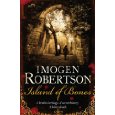Looking into early Georgian-era food for The Girl in the Mask and next year's book Smuggler's Kiss has been a delight. I discovered all sorts of gems, not all of which could be fitted into the stories.
 |
| Syllabub
|
First of all, I took a look at which foods were specifically popular at Bath at this time. Bath was famous for its mutton; this was a staple served in all the lodging houses. Hardly surprising when you consider this area's importance in the wool trade.
Soups (or, according to Eliza Smith's Compleat Housewife, 1858, 'soops') were many and varied. The gravy-soop sounds terribly rich; rather like a bowl full of beef and gravy. And the Fasting-day soup sounds a bit of a mixed bag: I love the sound of a whole onion stuck with cloves being dropped into the soup, but am less sure about the chopped lettuce (really? Cooked lettuce?) and spinach.
In the cook shops and bakeries and at the evening balls too, ladies were tempted by jellies and syllabubs. Jellies were boiled from the four bones of calves feet, spiced with nutmeg, mace and clove and coloured (sometimes in layers as 'ribbon jelly') with cochineal, spinach, saffron or syrup of violets. The instructions, to 'take out the bones of four calves feet' would daunt most present-day cooks, I imagine.
Syllabubs (pictured above) were basically double cream, sugar and lemon served with biscuits. I don't even like to think about how rich that must have been, but I'm no longer surprised that ladies at the Bath rarely took luncheon. In fact many of the dessert recipes seem to include several gallons of cream, including jelly posset; besides the ubiquitous calves feet, it was made with cream, pounds of sugar and pints of 'sack' or sweet sherry.
 |
| Sally Lunn's teashop |
 |
| Modern Bath buns |
Later in Bath's history, Dr Oliver invented a supposedly healthier alternative, the Bath Oliver biscuit, but that wasn't yet around at the period I'm writing about. However, they can still be found today if you're lucky.

When I looked further afield for Smuggler's Kiss, I found a few real delights. The most popular French dish at the time was 'ragout' - or, as the British called it, 'ragoo'. This stew often contained all manner of delights such as lamb's stones. I had to look that up. The private parts of male lambs - what a treat! Another treasure: pulled chicken. So-called because you 'pulled' all the raw meat from the bones, minced it finely, mixed it with herbs and breadcrumbs, and then (the mind boggles) apparently put it back on the bones and boiled it in a large bladder in a pot. I imagine this was a favourite dish for people who had cooks. Perhaps I'll stick with the syllabubs after all...
What I'm reading at the moment:


14 comments:
Syllabubs are delicious and not as rich as they sound. I've made them a few times. Gelatine was always made from boiled bones, calves' feet being the best source, until someone invented the packet stuff! I haven't tried a pulled chicken - yet.
yes, they sell Bath Olivers in Waitrose - and very dry and boring they are too. Give me a pint of double cream in a syllabub any time. Thanks for a fascinating post, Marie-Louise, which is also a nice starting point for research on my next book (set in Bath).
Morag, gelatine is still made of the same stuff!
Lettuce soup is delicious, Marie-Louise.
Have any of you ever had CHOCOLATE Bath Olivers? They are quite delicious - really thick dark chocolate with the healthy dull biscuit inside to make you feel virtuous!
Just up my street, this post! I hate the very idea of gelantine...don't know why, but syllabub is wonderful And so are Bath Olivers, esp with chocolate as Mary says.
..and again, seconding Mary, lettuce soup is smashing.
Eeugh...this stuff all sounds revolting! And what a lot of bother food preparation was in those days! Fun to research though.
I like Bath Olivers too! And perhaps this is not very à propos, but my most disturbing foody encounter was finding sheeps' teeth at the bottom of a stew I was eating in a cafe in Barcelona!
Ew, Katherine, that's too gross! Ann, I reckon a lot of this stuff was cooked by servants for the wealthy.
I've never much liked the idea of boiled bones and still avoid gelatine even though I'm no longer vegetarian - silly really. I love Bath Olivers though - the plain ones. You really shouldn't have told me there were chocolate ones, guys :)
I love all Bath Olivers, chocolate and plain. But the chocolate ones are sooo expensive! Great post, Marie-Louise!
I love all Bath Olivers, chocolate and plain. But the chocolate ones are sooo expensive! Great post, Marie-Louise!
I have several 18th-century cookbooks and do cook from them, so if you want anything looked up just ask! My favourite is William Verrall's fricasy of mushrooms (Mushrooms in white wine) - yum...
Jane, that sounds amazing!
Sally Lunn was FRENCH! This blogspot is such a mine of information. I love jellies but, like most of us today, there is no way I could bring myself to use calves feet. Another eighteenth-century favourite was calf's head pie. I put it into one of my books set in the period and children always want to know whether it was kept whole or chopped... Thanks for fascinating post.
The Belgians do peas with braised lettuce and pearl onions - it's absolutely delicious. And I now want to make a syllabub! I love whipped cream.
Post a Comment